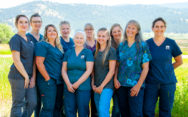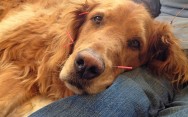Acupuncture Details
It is not necessary for you to understand acupuncture
in order for it to help your pet.
If you would like to learn more, then understanding acupuncture details as a treatment for your animals requires some expansion of thought. In our culture we operate with the logic that teaches that two opposite things cannot be true at the same time. Chinese culture holds the philosophy that teaches that two opposites can exist at the same time, and the existence of each depends upon the presence of the other, mutually consuming and producing each other, in a constant state of balance. This is the concept of Yin and Yang. In Chinese medicine, health is a state in which Yin and Yang are in harmonious balance. Where they are not in balance, there is disease.
Everything in the world, and everything in the body, can be described in terms of Yin and Yang. Things that are bright, hollow, hot, active and dry are more Yang. Dark, solid, cool, restful, and moist are Yin characteristics. Nothing is absolutely Yin or absolutely Yang; everything has some element of both. Darkness transforms into day, and the bright of day then transforms back into night. Coolness is a Yin feature, but “merely cool” is Yang when compared with “very cold.” There is no value judgment in which is more desirable, Yin or Yang. What is necessary is a balance between the two. When an animal has a TCM (Traditional Chinese Medicine) examination, for example, we might find that she has dry skin, pants all the time, is restless at night, and seeks cool places to lie down. She would be diagnosed in TCM as having a deficiency of Yin, and her treatment would be aimed toward correcting that deficiency.
Another important concept in TCM is understanding Qi (pronounced “chee”). Qi is the substance of everything in the physical world, in the form of energy, gas or solid. It is the life force of the body, the energy that flows through us and makes us alive, as well as the physical nature of our bodies. Nathan Sivin described it as “Matter on the verge of becoming energy, and energy on the verge of materializing.” It is derived from the food we eat, and the air we breathe, and from our parents at birth. Qi is always moving, flowing from our organs through our bodies, and the pathways it follows are called meridians. Where there is obstruction to the flow of Qi, there is disease.
Acupuncture is the insertion of needles into specific points on the meridians that affect the flow of Qi at those points and elsewhere in the body. Some acupuncture points have empirical actions, meaning that they have been shown over thousands of years of usage to have particular effects, such as the relief of pain in a certain area, or the stimulation of blood cell production. Others are called “master points” and have a beneficial effect on an entire region of the body. Some are diagnostic points, which when the individual shows sensitivity to them, indicate a disease in a particular organ or meridian.
In studying Western medicine, doctors learn a language of anatomy and disease and therapy. We learn about inflammation and infection by various microbes, and cell processes that can be manipulated in treating such ailments. In Traditional Chinese Medicine, or TCM, the language is older, and almost poetic. We learn about invasion of Wind, or Heat, or Dampness. TCM is concerned with the balance of processes in the body, and reestablishing its harmony. We can set aside the Western language and see the patient in the context of TCM, and treat within that context using the language of Qi and Yin and Yang. This form of medicine has been around for more than 2000 years.
Chinese medicine is not a religion. It is a system of seeing and evaluating and treating an individual to bring it toward a state of health. Like chiropractic, it uses the body’s own resources to facilitate a path toward wellness and balance.
It has been shown to be worthy of our attention.














